Ukemi
Ukemi means fall and encompasses any way of surviving a fall and falling to the ground unscathed. This also includes kaiten (rolls) and other body movements. The Ninja uses the techniques when his legs are knocked over, when he wants to get out of reach of the opponent, or when he wants to evade attacks.
Most martial arts neglect the ability to fall properly and then jump back up, continue fighting, or flee—although it would certainly be necessary. You don’t have a choice where to fight (unless you’re the attacker – and that’s NOT the point of Ninjutsu). This can be sitting in a train compartment, in a cramped broom closet, between tables and chairs in a canteen, or on a staircase.
A Ninja must be able to jump off a truck, leap over a high wall, or throw himself with lightning speed – to avoid a bullet.
First, the techniques are performed from a deep, squatting position in slow motion on a mat. Important points are lowering the center of gravity, exhaling, and body relaxation. Later, training takes place on a meadow, then on hard ground, asphalt, stairs, etc.
Zenpō kaiten – Forward Roll
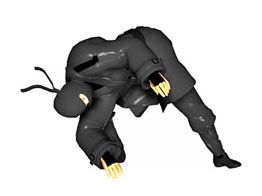
From the defensive position, the body is bent forward so that it forms an arch, starting from the outstretched lead arm and the shoulder. The head is pulled down and one rolls over the leading arm, shoulder, back, and hip. The legs remain pressed tightly to the floor during the roll, the head does not touch the floor.
- two-handed (ryōte)
- one-handed (katate)
- without hands (mūte)
Kōhō kaiten – Backward Roll
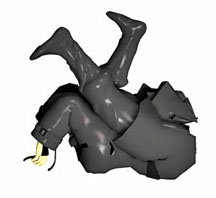
From the defensive position, you drop straight to the ground. The back is bent forward and the head is drawn in. During the roll, the legs remain close to the body. It is rolled sideways over the shoulder.
- two-handed (ryōte)
- one-handed (katate)
- without hands (mūte)
Sokuhō kaiten – Side Roll
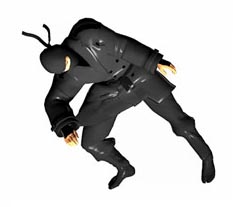
From the defensive position, bring the body’s center of gravity over one of the legs and swing the other leg up in an arc in front of the supporting leg. Then you let your buttocks go to the ground and lift your outstretched leg so that your body rolls over your back.
- two-handed (ryōte)
- one-handed (katate)
- without hands (mūte)
Zenpō ukemi – Forward Fall
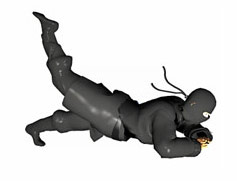
When you start practicing the forward fall, you should do it on your knees. The forearms form a triangle, palms and forearms catch the fall. The chin is pulled up to avoid hitting the face with the ground. When performing zenpō ukemi from a standing position, one leg is extended upwards.
- on the knees two-handed (ryōte)
- on the knees one-handed (katate)
- standing two-handed (ryōte)
- one-handed while standing (katate)
Kōhōukemi – Backward Fall
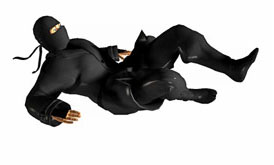
When falling backward, you hit the ground next to you with your arms and hands at an angle of 45°. One leg is bent and the sole of the foot is on the floor, the other leg is bent sideways inwards. The foot is first placed sideways with the outside flat on the floor. The chin is pressed against the chest so that the back of the head does not hit the ground.
- on the knees two-handed (ryōte)
- standing two-handed (ryōte)
Sokuhō ukemi – Sideways Fall
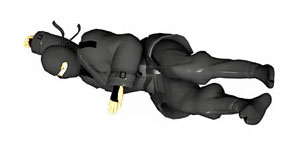
When falling sideways, you hit the ground sideways with your arm stretched out at a 45° angle and your palm on the ground. However, you do not fall on your back, but on the side of your body (hip, ribs, shoulder). The head is kept off the ground. The legs are extended straight up in the air together about 45° off the floor.
- standing to the left side (hidari katate)
- standing to the right side (migi katate)
Nagare – Flowing Water
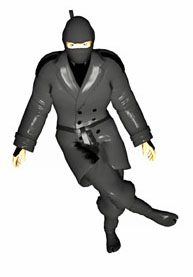
Nagare means to fall in such a way that there is no sound, soft and flowing like water. In doing so, you first approach the ground flat with your legs and lower your body’s center of gravity, and sometimes continue to roll straight away so that no noise can arise.
- standing backward (tachi nagare)
- while standing to the right (migi yoko nagare)
- while standing to the left (hidari yoko nagare)
- Growing backward (kōhō tomoe nagare)
- Rolling backward (kōhō kuruma nagare)
- From ichimonji no kamae (jun nagare)
- From ichimonji no kamae (gyaku nagare)
Shihō tenchi tobi – Leaping in Four Directions, to Heaven, and Earth
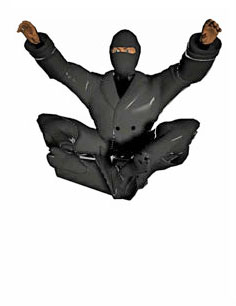
The jumps in Ninjutsu are performed lightly and loosely so that they are almost silent. You practice jumping flat and far to the left, right, front, and back. Ten means to jump high in the sky, chi means to hunker down and drop the body to the ground.
- forward (mae)
- backward (kōhō)
- to the right (migi)
- to the left (hidari)
- up (ten)
- down (chi)
Oten – Cartwheel
Cartwheeling can be used to escape from a side attack or to free yourself from a lever.
- With one hand (katate)
- With two hands (ryōte)
- without the use of hands (mūte)
Kiten – Hand Jump
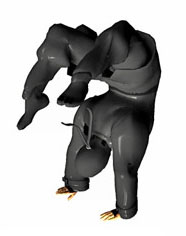
From an upright position, arms straight, jump forward, backward, or to the side and down so that your body weight is over your bent arms. The arms push the body up and the bent legs are suddenly stretched out in the direction of the fall. The back is arched and the hips point in the same direction as the feet.
- two-handed forward (mae ryōte)
- one-handed forward (mae katate)
- two-handed backward (kōhō ryōte)
- one-handed backward (kōhō katate)
- two-handed sideways to the right/left (migi/hidari ryōte)
- one-handed sideways to the right/left (migi/hidari katate)
Kūten – Air Turn
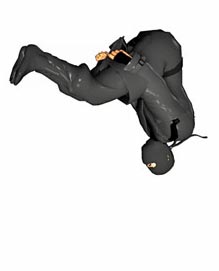
Once you’ve mastered the handstand rollover, you can switch to the air turn, jumping up and forward or back with a jerk, pulling your legs to your body and rotating around your own axis in the air.
- forward (mae)
- backward (kōhō)
Kūhi – Air Jump
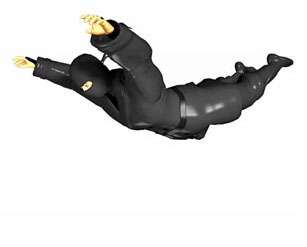
The air jump is performed when you lunge at an opponent or when you jump over an obstacle. You can either roll or catch the fall with your hands and forearms.
Shōten no jutsu – The Art of Soaring Into the Sky
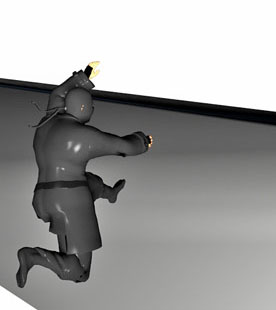
To run up a wall, fence, tree, or person you need to be fast enough, and if the moment of inertia is high enough you can jump at the object, push up with your legs and jump over it.
For practice, you can use a board that you set up at an ever-increasing angle.
- jump down from above (tobi ori)
- run up vertical surfaces (shoten)